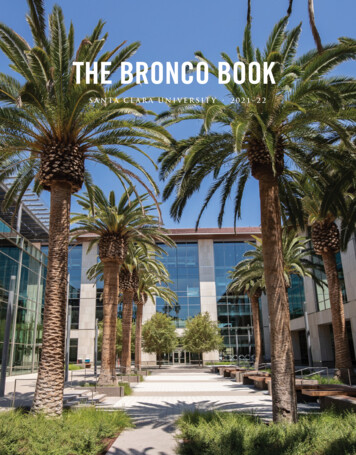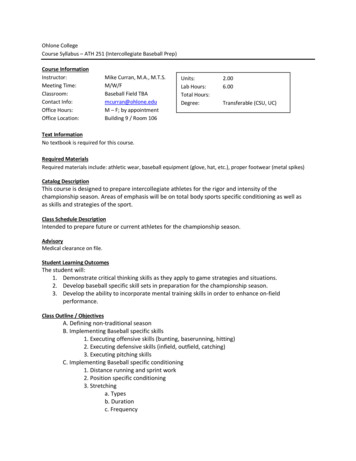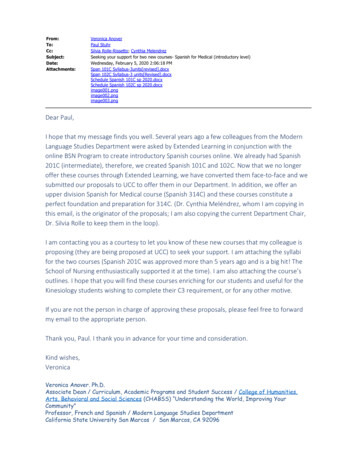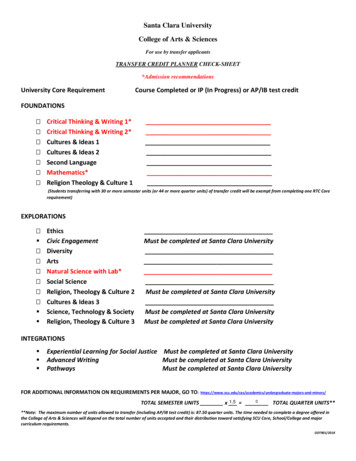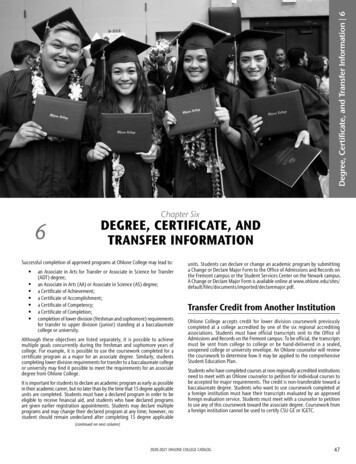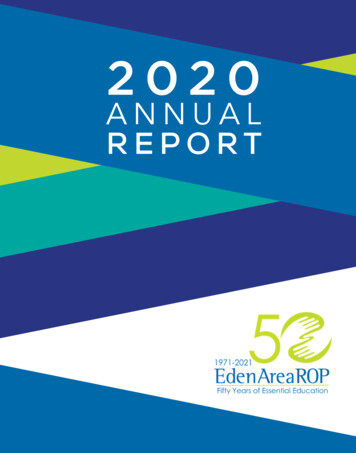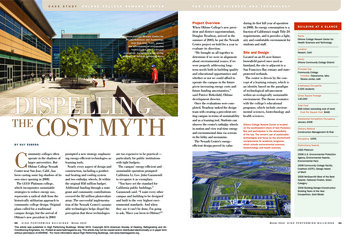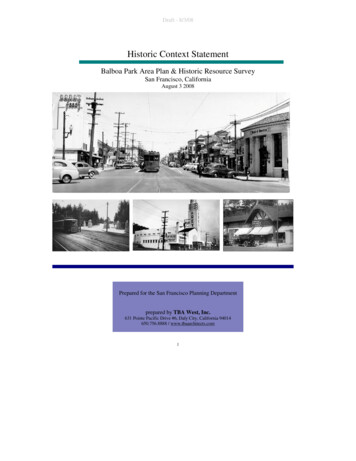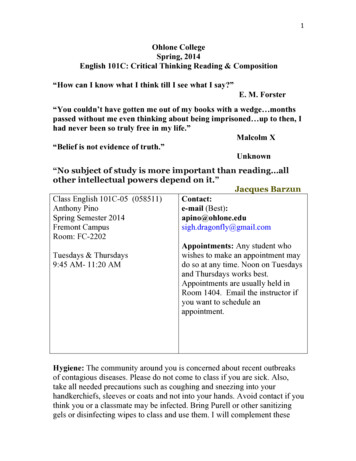
Transcription
1Ohlone CollegeSpring, 2014English 101C: Critical Thinking Reading & Composition“How can I know what I think till I see what I say?”E. M. Forster“You couldn’t have gotten me out of my books with a wedge monthspassed without me even thinking about being imprisoned up to then, Ihad never been so truly free in my life.”Malcolm X“Belief is not evidence of truth.”Unknown“No subject of study is more important than reading allother intellectual powers depend on it.”Jacques BarzunClass English 101C-05 (058511)Contact:Anthony Pinoe-mail (Best):Spring Semester 2014apino@ohlone.eduFremont Campussigh.dragonfly@gmail.comRoom: FC-2202Appointments: Any student whoTuesdays & Thursdayswishes to make an appointment may9:45 AM- 11:20 AMdo so at any time. Noon on Tuesdaysand Thursdays works best.Appointments are usually held inRoom 1404. Email the instructor ifyou want to schedule anappointment.Hygiene: The community around you is concerned about recent outbreaksof contagious diseases. Please do not come to class if you are sick. Also,take all needed precautions such as coughing and sneezing into yourhandkerchiefs, sleeves or coats and not into your hands. Avoid contact if youthink you or a classmate may be infected. Bring Purell or other sanitizinggels or disinfecting wipes to class and use them. I will complement these
2efforts by bringing in some additional sanitizing products.MANAGEMENT OF STRESS AND MENTAL HEALTH:Often the pressure on our students is very strong, involving academiccommitments, relationships, outside jobs and family pressure to name a few.This is especially true among international students. The staff and faculty ofOhlone College are here to see you succeed academically and care aboutyour emotional and physical health. You can learn more about the broadrange of confidential student services, including counseling and mentalhealth services available on campus by visiting the Student Health Center inbuilding 7 or http://stepupohlone.org/oncampus-resources/. The CrisisSupport Services of Alameda County offers a 24-Hour Crisis Line: 1-800309-2131.VALUABLES LEFT IN CLASS ROOM:If I find that you have left valuables in the classroom --- such as cell phones,purses, laptops or jewelry---I will take them to the Campus Police to beplaced in the Lost and Found box. DO NOT PANIC! Send me an email ifyou think you have done this and I will let you know if I found something.THE ENGLISH LEARNING CENTER (ELC)The ELC complements this course by providing you with assistance inwriting. It also provides testing services for the Lab piece of this course. Thelaboratory testing feature is mandatory; you will NOT pass this course ifyou do not take the Lab. You should also use the ELC for writingassistance, especially if the instructor recommends it.COURSE TEXTSRequired for Class: Rottenberg & Winchell Behrens and Rosen, Elements ofArgument: A Text and Reader, 10th ed. (required) Novel: Fahrenheit 451 byRay Bradberry and God Bless You, Mr. Rosewater by Kurt Vonnegut.Recommended for Class: Any sound style guide, such as Trimble‘s WritingWith Style, 2nd ed. or others suggested by the instructor; or strongfamiliarity with the Online Writers’ Guide (Purdue University) (OWL), theDuke University Libraries Writing Studio and LEO (Literacy Education
3Online (St. Cloud State). Handouts provided in class.COURSE DESCRIPTION & OBJECTIVESWhat is argument? What is the difference between a written and averbal argument, and why should we study the argumentative processat all? What does it mean to have the freedom to study this process?And what does “freedom” itself even mean? These are the types ofquestions and issues we will be exploring in this course, a coursewhich is designed to help students develop their abilities to thinkcritically and to write effective academic arguments. Throughout thesemester, we will analyze, evaluate, and respond to arguments from avariety of sources, from ancient Greek texts to contemporary articles,films, advertisements, and political cartoons. Hopefully, by the end ofthis course, students will be viewing the world through much morecritical and discerning eyes and will have a clearer understanding ofthe way people use language not only to communicate ideas andinformation, but to persuade others to change their way of thinkingand even to take action. perform basic research techniques in severalwriting assignments.STUDENT LEARNING OUTCOMESThe student will:1. Explain the differences between effective, valid argumentation andunclear and/or invalid reasoning.2. Identify common logical fallacies and examples of fallaciousreasoning.3. Write out-of-class and/or in-class, well-organized critical essayswhich state clear and arguable theses and which are supported bylogical argumentation and sufficient evidence.4. Recognize both deductive and inductive forms of reasoning andpresent and defend either orally or in written form ideas in a clear andlogical manner.5. Analyze and criticize ideas from or about specific nonfiction works.6. Present clear, precise, and accurate oral analyses (includingsummary, critique, evaluation, synthesis) of critical thinking conceptsor of specific works through activities such as Socratic questioning,discussions, oral reports, presentations, or debates.
47. Write informally on topics by showing an awareness of tone,audience, and support for one's conclusions.8. Clearly explain the differences between knowledge/fact andopinion in the student's own writing and in others' works.STUDENT ACTIVITIES & ASSIGNMENTS1) READINGS, QUIZZES & HOMEWORKActivities will include weekly assigned readings and class discussionbased on the readings. Occasional homework and quizzes willinclude exercises on analyzing and evaluating short arguments fromour text. Weekly topics will include basic elements of argument,definition, persuasive language use, inductive and deductivereasoning, and logical fallacies. We will be picking apart as well asconstructing arguments, and we will be doing a lot of talking andarguing about issues which come up along the way.Each student will also present an analysis to the class of one of theweekly editorials from the Sunday SF Chronicle, the San JoseMercury, the New York Times, the Washington Post or the LosAngeles Times (all available online), which we will be followingthroughout the course. A write-up will be due with the presentation.The write up and analysis should include: (1) the claim being made bythe writer and its context (i.e., the general controversy around theclaim), and whether it pertains to fact, value or policy; (2) the supportfor the claim, whether it is consistent, credible and relevant, andwhether it includes motivational appeals; and (3) the warrant (theassumptions, beliefs or principles) for the argument. The write shouldnot exceed 1 and one-half pages.2) PAPERSOver the course of the semester, students will write a total of threepapers of varying lengths (with rough drafts), one of which willrequire some research. Papers will be based on class readings and onfilms related to the readings.
5Classes will include small-group review (“peer review”) of studentdrafts, and students will be graded on written feedback given toothers. Rough drafts must be handed in with final drafts when papersare due as revision work is taken into consideration when papers aregraded. Not having a draft or being absent on a peer review day(or not turning in a draft when the final paper is due) will reducethe assessment by one grade (A- becomes a B ).Each paper will identify at least two positions on a topic. The studentwill state and describe the claim in each position, discuss thesupporting evidence for each, and identify the warrant behind theargument. Each claim will be identified as a claim of fact, value orpolicy, or combinations of these.At the end of the semester, students will write an argumentativeresearch paper (Paper #3) on a topic of their choice, which is alsorelated to our readings.3) RESEARCH PRESENTATIONToward the end of the semester, students will sign up for a grouppresentation which will be based on information students will bepresenting in their research papers. Groups will meet both inside andoutside of class to determine the scope and direction of the researchand to design a creative format for the presentation. Groups willpresent various perspectives on an issue, either as a formal debate orin a more informal and creative manner (i.e. a mock game show, talkshow, news cast, etc.). A brief write-up will be due with thepresentation. Specific requirements will be provided in writingseveral weeks in advance of the presentation due date.4) COURSE CONDUCTNo extra credit work is provided.Students are expected to bring their assigned texts to class dailyand to be prepared to discuss that material in a respectful,courteous manner.Private conversations and texting are saved for out-of-class time.Pagers and cellular phones are turned off during class.
6The student is responsible for attending class regularly. Much ofthe preparatory work for the assignments occurs during classtime. Students who miss four or more class days will probablynot receive course credit.A student is expected to be in class on time. Consistent tardinesswill result in unexcused absences (three tardies one unexcusedabsence).MISSING CLASS IS NOT AN EXCUSE FOR COMINGUNPREPARED OR FOR NOT DOING WORK. A studentwho misses class is responsible for finding out what s/he needsto do for class/homework in order not to fall behind. Getting theemail address of at least two “study buddies” is required.Students must respect the privacy and space of each studybuddy, and not cause any stress or distress to these classpartners.Students should contact the instructor ahead of time or on the dayof an absence; this absence, if legitimate, will not count against thestudent. Only students who notify the instructor of an absencewill be allowed to turn in missed assignments. Otherwise, lateassignments will not be collected and graded. The instructor is oncampus in the mornings. The instructor will not receive emails orvoice mail messages left in the afternoon or evening until the nextday.CLASSROOM DECORUMThis course often involves the adoption of positions which areobjectionable or unappreciated by other students. You are not free tomock or publicly scoff at those positions. The Rogerian argumentativemodel seeks conciliation among the parties---a model which requiresempathy and substantial analysis of the other party’s points of view.Conciliation would be set back by disrespect of another’s position.Please withhold judgment of another’s viewpoint until all the facts aredeveloped and discussed.EVALUATIONGrading is based on the number of points accumulated during thesemester. These points will be converted into percentages (which followthe standard scale of 100-90% A, 89-80% B, 79-70% C, 69-60% D, 59-
70% F) and then into letter grades. The final grade breakdown follows:In-class Book of Questions Responses 50 pointsOther in-class responses & quizzes 50 pointsIn-class essays typed at home75 pointsOutside essays150 pointsResearch papers200 pointsClass presentation150 pointsKeep all your course work for the entire semester.Keep all your course work for the entire semester.Keep all your course work for the entire semester.COURSE ATTENDANCEStudents are expected to attend classes regularly. A maximum of fourabsences will be permitted. If that limitation is exceeded, the Instructor maychoose to terminate the student’s participation in the course. If the student ispermitted to continue, a one-grade reduction will be made with eachsuccessive absence. For example, a student with an A- will receive a B .ENROLLMENTAdding the class (with the instructor’s permission) will be done by theinstructor through Web Advisor. Students take the responsibility towithdraw from the course if they feel they are unable to complete the courseor if they stop attending class. The student should be aware of the finalwithdrawal date on Friday, April 25, 2014. Failure to properly drop theclass may result in a failing grade.DEADLINESPlease meet all deadlines. Specific homework assignments are often given inclass and are not listed on the syllabus. Essays are due at the beginning ofclass. No make-up quizzes or exams will be given. No late homeworkwill be collected. No late essays will be accepted.WRITTEN WORKEnglish 101C students are expected to use the MLA style when writing any
8formal essay. An example of this style will be given to students prior to thefirst out-of-class writing assignment. All out-of-class papers must be typedor word-processed in order to receive credit. Emailed essays are notaccepted—printed versions only. Class work in most cases may be takenhome for typing.PLAGIARISM ----IMPORTANT!!!!! READ THIS!!!!The Ohlone College policy on Academic Integrity clearly explainsunacceptable behavior. This policy includes cheating, copying directly fromsomeone else’s work or a source without using the proper citation, andresubmitting a paper from another class. These offenses will result in failinggrades (Zero (0) points). The student’s name and offense will be reported tothe Vice President of Student (J edgesoyoumaystartwithit.ENGLISHFLUENCY- ‐“TheRuleofTen(10)”Anystudent- pectedtoreturnthepaperwithinfiveschool
9days.ThemaximumgradeattainablewillbeaC fortherevisedpaper.REWRITES- NO INSTRUCTOR PREREADINGThe Instructor will not pre-read student work. This would multiply theinstructor’s workload and discourages the student from producing the bestwork possible. Assistance is available at the English Learning Center, ormay be acquired by the student through other means, such as a friend whohappens to be a good writer.ERRORS IN THE SYLLABUS OR AMENDMENTSIf a student finds an error or contradiction in any Syllabus or Amendment,please inform the Instructor so that a clarification can be issued.GIFTSSome students like to give their teachers gifts at the end of the semester. I donot accept gifts, so please do not give me anything. If you feel happy aboutmy teaching, please send me an email sometime and tell me how you aredoing. I really like to know about my students’ work and successes.USE OF CELL PHONES AND TEXTING IN CLASSUse of cell phones and texting in class is considered disrespectful and adisengagement from learning. If I find you texting or using a cell phone inclass, I will take the phone from you for the rest of the class and give you acell phone ticket, which includes your name and Student ID number. I willreturn the phone at the end of class. You will receive an absence for thatcourse day. Two citations will result in one grade reduction (A- to B or Bto C ).DIVERGENT THINKING
10Divergent thinking is at the heart of argument, social change and democracyitself. It must remain alive and well in our classrooms. Students can feel freeto disagree with this Instructor on any and all rhetorical matters withimpunity. In fact, students may be encouraged to disagree on occasion. Theonly limitation on this freedom is that the rules of the MLA and academicgrammar and syntax be honored without dispute. Let’s look forward to ourdiscourse.MONTHLY WORK SCHEDULE – A monthly work schedule will bepresented within the first week of class. It will provide assignments and duedates.
11OHLONE COLLEGEPOLICY ON ACADEMIC INTEGRITYWhat is Academic Dishonesty?Academic dishonesty occurs when a student attempts to show possession ofa level of knowledge or skill which he or she does not possess. The two mostcommon kinds of academic dishonesty are “Cheating” and “Plagiarism.”Cheating is the act of obtaining or attempting to obtain credit for academicwork through the use of dishonest, deceptive, or fraudulent means.Plagiarism is representing the work of someone else as your own andsubmitting it to fulfill academic requirements.It is your responsibility to know what constitutes academic dishonesty.If you are unclear about a specific situation, speak to your instructor. Thefollowing list exemplifies some of the activities defined as academicdishonesty.CheatingCopying, in part or in whole, from someone else’s test.Submitting work presented previously in another course, if contrary tothe rules of either course.Altering or interfering with grading.Using or consulting, during an examination, any sources of materials notauthorized by the instructor.Committing other acts which defraud or misrepresent.PlagiarismIncorporating the ideas, words, sentences, paragraphs, or parts of anotherperson’s writings, without giving appropriate credit, and representingthe product as your own work.Representing another’s artistic/scholarly works (such as musicalcompositions, computer programs, photographs, paintings, drawings,or sculptures) as your own.Submitting a paper purchased from a research or term paper service.Other Specific Examples of Academic DishonestyPurposely allowing another student to copy from your paper during a test.Giving your homework, term paper, or other academic work to anotherstudent to plagiarize.Having another person submit any work in your name.Lying to an instructor or university official to improve your grade.Altering a graded work after it has been returned, then submitting thework for re-grading.Removing tests from the classroom without the approval of the
12instructor.Stealing tests.Having a typist correct work for spelling or grammar, if contrary to therules of the course.Forging signatures on drop/add slips or other college documents.Consequences of Academic DishonestyAcademic and/or administrative sanctions may be applied in cases ofacademic dishonesty.Depending on the seriousness of the infraction, you may:Receive a failing grade on the test, paper, or exam;Have your course grade lowered, or possibly fail the course;Under the standards of student conduct a student may receive a:WarningReprimandProbationSuspensionExpulsionThe Vice President of Student Development maintains a record of studentswho have engaged in academic dishonesty. This information is used toidentify and discipline students who have been reported for academicdishonesty more than once.Ohlone College English 101CStudents will learn critical thinking skills and use them to read and evaluateessays in a precise, logical way. The emphasis will be upon critical analysisand upon the students’ development of effective, written arguments.Why we write about art and filmThis English class uses art and often film as focal points for writing.Works of pictorial art and film are terrific sources and opportunities to learnabout cultural and social issues and values as well as historical contexts.They are certainly windows to knowledge, as we gain insight into the artist’sissues with the society around him or her.In the world of education, we use the term “scaffolding” to describesuch contextual knowledge-building. Eventually, these slices of learning willcoalesce (come together) as you analyze and synthesize them. These areprocesses which build student awareness of the world around them andeventually enable the student to make predictions and to speak
13knowledgeably of past events and patterns of human behavior. We call suchpeople “erudite” and “educated.” We look to them for answers in givensituations. Like it or not, they are our leaders, and this is the role educationhas in our society.In this class we will discuss the social, psychological and historicalcontexts of art, as well as the artistic techniques of these works asbackground for writing exercises. Usually, these exercises are brief,“Summary Response” essays, two to five paragraphs, which give the studentan opportunity to provide descriptive observations and backgroundinformation---an awareness of what’s going on in the work--- and a personalresponse/interpretation of the piece. These essays may become a part of thestudent’s working portfolio (if one is required by the Syllabus) or academicrepertoire for future classes and applications.Summary-Response essays are composed in two phases:-First, a detailed description of the work, which would includethe colors, arrangements, images, contrasts, tones, moods, methods, shapes,textures, processes, techniques, and overall composition (among otherartistic concepts); and may also include interpretive data or importantcontextual information about the surrounding society or culture.-Second, a response to the work, which would include yourinsight and disposition as to the results of the art piece---your assessment ofthe artistic achievement or effects, and perhaps, an explanation as to how orwhy this work achieved a place of reverence in Western (or Eastern) art.*Again, these discussions are opportunities to reveal your knowledgeand skill as writers, and I would expect serious preparation for them. Asalways, we cannot tolerate plagiarism, and your work must not include anyundocumented references.*Words of caution: I do not expect my students to “like” any particularwork, but to possess a working knowledge of the ideas presented in thework. I invite and encourage well-reasoned criticism. But it is absolutelyessential that the student be aware of the ideas which the work conveys. If Iselect a film you have seen before, you are not excused from seeing it againin class. I will from time-to-time stop the film to make comments about it orto interject some perspective on plot, character, mise en scene or some otherfilm issue.
14WRITINGRUBRICFLUENT,COLLEGE- ngthatisfreeofrun- tacticalerrors,includingtenses,subject- lead- ent(25%).
15WEEKLY SCHEDULE(please allow for changes as needed)First Week of Class Activity - Tues Jan 28 – Thu Jan 30Tuesday - Introduction to course - introductions to each other introductions to methods of class presentation - readings - compositions - art- film - The Book of Questions/Un-journaling - Intro to Elements ofArgument and Fahrenheit 451 and God Bless You, Mr. Rosewater words/phrases to avoid - samples of style guides, and what’s on line.Deceased words-à “The Red List.” The Academic Word List.Discussion & Elements: Personal introductions; exchanges of emailaddresses. Discussion of Syllabus. Discussion of Chapter 1, the nature andhistory of argument: the Greek background, Rogerian argument, StephenToulmin, the feminists. Key terms of argument: Claims, Support andWarrants. The Audience. Essays on current issues. “Coming to anAwareness of Language.”Homework – 1. Begin reading Chapter 1 of Elements of Argument (EOA).2. Look up the Academic Word List and become familiar withit.3. Go to page 458 of the EOA and examine the MLA style ofwriting in the sample; see how quotations are blocked how intext citations are arranged; how pagination is ordered withinthe header of the paper; and how the Works Cited page isarranged, in alphabetical order and using hanging indentation.This is the academic writing format we will use in this class.Thursday - Discussion & Elements: Discuss Chapter 1. of EOA on theApproaches to Argument, the Rhetorical Triangle, the Rogerian argumentmethod, the influence of the feminists, the work and methods of StephenToulmin. Review and discussion of some of the topical essays in Chapter 1.Homework: 1. Continue reading Chapter 1. Be prepared to ask questionswhen you don’t understand something. Donotoverlookpages28–
2. Go to the Anthology of Essays beginning on page 497(unnumbered) and look for an essay that you’d like to write your ownessay about, using the analytical tools of claim, support and warrant,ethos, logos and pathos upon which to base your discussion. Thatpaper will be due on March 4 for peer review and March 6 forsubmission. It must be a minimum of three pages and use hursFeb6Tuesday–Continued discussion of essays and commentary with smallgroups EOA, Chapter. 1, and handout “Triumph of the adandre- cussionsofChapter2onCriticalReading.Pre- ngonyourfirstessay.3.ContinuereadingFahrenheit451.
shopessays.
–ThursFeb27Tuesday- kofClassActivity–TuesMar4–ThursMar6
19Tuesday–In- sUp!!Begindiscussionofsocial- sionofsocial- ingChapter5of
apino@ohlone.edu sigh.dragonfly@gmail.com Appointments: Any student who wishes to make an appointment may do so at any time. Noon on Tuesdays and Thursdays works best. Appointments are usually held in Room 1404. Email the instructor if you want to schedule an appointment. Hygiene: The community around you is concerned about recent outbreaks
